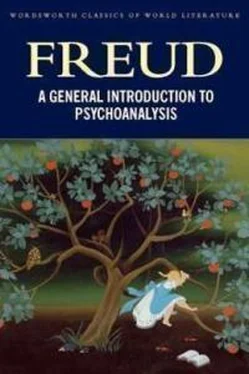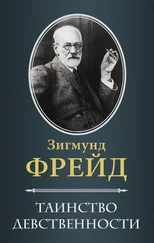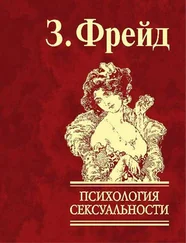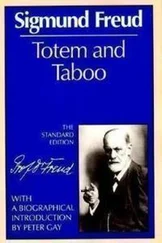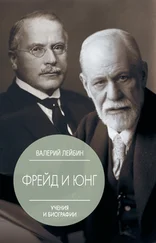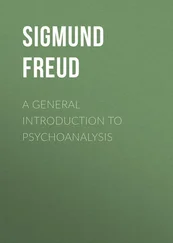Substitution by allusion is known to our conscious thinking also, but with a difference. In conscious thinking the allusion must be easily intelligible, and the substitute must bear a relation to the actual content. Jokes, too, often make use of allusion; they let the condition of content associations slide and replace it by unusual external associations, such as resemblances in sound, ambiguity of words, etc. They retain, however, the condition of intelligibility; the joke would lose all its effect if the allusion could not be traced back to the actual without any effort whatsoever. The allusion of displacement has freed itself of both these limitations. Its connection with the element which it replaces is most external and remote, is unintelligible for this reason, and if it is retraced, its interpretation gives the impression of an unsuccessful joke or of a forced, far–fetched explanation. For the dream censor has only then accomplished its purpose, when it has made the path of return from the allusion to the original undiscoverable.
The displacement of emphasis is unheard of as a means of expressing thoughts. In conscious thinking we occasionally admit it to gain a comic effect. I can probably give you an idea of the confusion which this produces by reminding you of the story of the blacksmith who had committed a capital crime. The court decided that the penalty for the crime must be paid, but since he was the only blacksmith in the village and therefore indispensable, while there were three tailors, one of the latter was hung in his stead.
The third process of the dream–work is the most interesting from a psychological point of view. It consists of the translation of thoughts into visual images. Let us bear in mind that by no means all dream thoughts undergo this translation; many of them retain their form and appear in the manifest dream also as thought or consciousness; moreover, visual images are not the only form into which thoughts are translated. They are, however, the foundation of the dream fabric; this part of the dream work is, as we already know, the second most constant, and for single dream elements we have already learned to know "plastic word representation."
It is evident that this process is not simple. In order to get an idea of its difficulties you must pretend that you have undertaken the task of replacing a political editorial in a newspaper by a series of illustrations, that you have suffered an atavistic return from the use of the alphabet to ideographic writing. Whatever persons or concrete events occur in this article you will be able to replace easily by pictures, perhaps to your advantage, but you will meet with difficulties in the representation of all abstract words and all parts of speech denoting thought relationships, such as particles, conjunctions, etc. With the abstract words you could use all sorts of artifices. You will, for instance, try to change the text of the article into different words which may sound unusual, but whose components will be more concrete and more adapted to representation. You will then recall that most abstract words were concrete before their meaning paled, and will therefore go back to the original concrete significance of these words as often as possible, and so you will be glad to learn that you can represent the "possession" of an object by the actual physical straddling of it. [32]The dream work does the same thing. Under such circumstances you can hardly demand accuracy of representation. You will also have to allow the dream–work to replace an element that is as hard to depict as for instance, broken faith, by another kind of rupture, a broken leg. [33]In this way you will be able to smooth away to some extent the crudity of imagery when the latter is endeavoring to replace word expression.
In the representation of parts of speech that denote thought relations, such as because , therefore , but , etc., you have no such aids; these constituent parts of the text will therefore be lost in your translation into images. In the same way, the dream–work resolves the content of the dream thought into its raw material of objects and activities. You may be satisfied if the possibility is vouchsafed you to suggest certain relations, not representable in themselves, in a more detailed elaboration of the image. In quite the same way the dream–work succeeds in expressing much of the content of the latent dream thought in the formal peculiarities of the manifest dream, in its clearness or vagueness, in its division into several parts, etc. The number of fragmentary dreams into which the dream is divided corresponds as a rule to the number of main themes, of thought sequences in the latent dream; a short preliminary dream often stands as an introduction or a motivation to the complementary dream which follows; a subordinate clause in dream thought is represented in the manifest dream as an interpolated change of scene, etc. The form of the dream is itself, therefore, by no means without significance and challenges interpretation. Different dreams of the same night often have the same meaning, and testify to an increasing effort to control a stimulus of growing urgency. In a single dream a particularly troublesome element may be represented by "duplicates," that is, by numerous symbols.
By continually comparing dream thought with the manifest dream that replaces it, we learn all sorts of things for which we were not prepared, as for instance, the fact that even the nonsense and absurdity of the dream have meaning. Yes, on this point the opposition between the medical and psychoanalytic conception of the dream reaches a climax not previously achieved. According to the former, the dream is senseless because the dreaming psychic activity has lost all power of critical judgment; according to our theory, on the other hand, the dream becomes senseless, whenever a critical judgment, contained in the dream thought, wishes to express the opinion: "It is nonsense." The dream which you all know, about the visit to the theatre (three tickets 1 Fl. 50 Kr.) is a good example of this. The opinion expressed here is: "It was nonsense to marry so early."
In the same way, we discover in interpretation what is the significance of the doubts and uncertainties so often expressed by the dreamer as to whether a certain element really occurred in the dream; whether it was this or something else. As a rule these doubts and uncertainties correspond to nothing in the latent dream thought; they are occasioned throughout by the working of the dream censor and are equivalent to an unsuccessful attempt at suppression.
One of the most surprising discoveries is the manner in which the dream–work deals with those things which are opposed to one another in the latent dream. We already know that agreements in the latent material are expressed in the manifest dream by condensations. Now oppositions are treated in exactly the same way as agreements and are, with special preference, expressed by the same manifest element. An element in a manifest dream, capable of having an opposite, may therefore represent itself as well as its opposite, or may do both simultaneously; only the context can determine which translation is to be chosen. It must follow from this that the particle "no" cannot be represented in the dream, at least not unambiguously.
The development of languages furnishes us with a welcome analogy for this surprising behavior on the part of the dream work. Many scholars who do research work in languages have maintained that in the oldest languages opposites—such as strong, weak; light, dark; big, little—were expressed by the same root word. ( The Contradictory Sense of Primitive Words. ) In old Egyptian, ken originally meant both strong and weak. In conversation, misunderstanding in the use of such ambiguous words was avoided by the tone of voice and by accompanying gestures, in writing by the addition of so–called determinatives, that is, by a picture that was itself not meant to be expressed. Accordingly, if ken meant strong, the picture of an erect little man was placed after the alphabetical signs, if ken , weak , was meant, the picture of a cowering man followed. Only later, by slight modifications of the original word, were two designations developed for the opposites which it denoted. In this way, from ken meaning both strong and weak, there was derived a ken , strong, and a ken , weak. It is said that not only the most primitive languages in their last developmental stage, but also the more recent ones, even the living tongues of to–day have retained abundant remains of this primitive opposite meaning. Let me give you a few illustrations of this taken from C. Abel (1884).
Читать дальше
